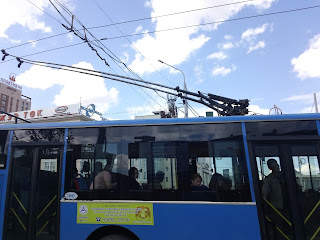I went recently to the Gandantegchinlen Tibetan Buddhist Monastery. I'm told it's the largest in Mongolia; it's definitely quite impressive. The Monastery is staffed by monks, properly referred to with the Tibetan title Lama, as you can see in the name Dalai Lama. These monks are available to give children auspicious names, tell people auspicious days to do things, and read prayers in Tibetan. Mongolian believers will either have prayers read for prosperity in their current life or to get Karma for a better reincarnation.
If you are anything you'll want to to get a closer look at the cool writing up there!Or you could look at the exquisite carving and painting, I suppose.
I went in and wandered about for a bit until I found a Lama who looked friendly and asked him if I could talk to him.
This is Myagmarsuren. He is just 22 years old and has been a Lama for 5 years.
He told me that he decided to become a Lama because he was interested in Tibetan, the liturgical language here. He sometimes goes with senior Lamas to bless houses and babies, but a lot of his time is spent memorizing tibetan scriptures such as the Chogchen sutra, the Six Blessings and the 10 protections. The life of a Tibetan buddhist Lama involves many restrictions and vows, such as not marrying. Unlike many Buddhist traditions, I was told that most Mongolian monks do eat meat, as Mongolian cuisine just about mandates it. They ensure that animals are slaughtered humanely, and they even read prayers for these animals to ensure they are reincarnated in a better position, perhaps even as humans. The Lamas are also required to wear robes as in the picture above, and Myagmarsuren says he wears normal clothes only on very rare occasions.
He offered to show me around some of the more interesting parts of the Monastery. He showed me this mural depicting many of Tibetan Buddhist deities. He worked on some of the background work and the two outermost pavilions pictured.
He explained that the Gandantegchinlen monostary has a history spanning more than 150 years, though it was used to house soldiers in the era of World War II while Mongolia fought for independence. The temple is full of exquisitely made Buddhas and other icons, which Myagmarsuren said people brought in droves after Communist rule ended. They brought all religious items they had hidden for years and filled the monastery with them. Even before that, he told me the story of a man named Talkh (which means 'bread,' if you're curious) who helped found the monastery. Talkh was a rich herder who had his hand in the slaughter of countless animals. One day an epiphany led him to realize how much sin he had accumulated in slaughtering his animals, and so he helped found Gandantegchinlen monastery to generate good Karma.
Myagmarsuren offered to give me pointers in reading Tibetan Sutras, which requires not only navigation of labyrinthine tibetan orthography, but also knowledge of liturgical tradition and proper chants. My interest in this is primarily linguistic, but it has been fascinating to learn more about Tibetan Buddhist beliefs from a man who dedicated his life to them.

























